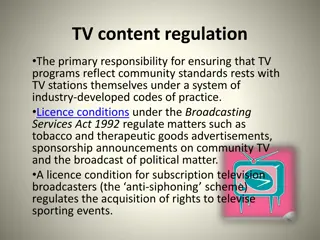Understanding Television Research: Markets, Measurement, and Methodologies
Explore the world of television research through topics such as television markets, measurement approaches, local measurement services like Nielsen and Comscore, and Nielsen's measurement methodologies. Learn about Designated Market Areas (DMAs), Household Demographics, People Meters, Portable People Meters, and more.
Download Presentation

Please find below an Image/Link to download the presentation.
The content on the website is provided AS IS for your information and personal use only. It may not be sold, licensed, or shared on other websites without obtaining consent from the author. Download presentation by click this link. If you encounter any issues during the download, it is possible that the publisher has removed the file from their server.
E N D
Presentation Transcript
Table of Contents Television Markets TV Measurement & Methodology Television Distribution Television Stations Media Terminology & Formulas Rating, Share, HUT Media Formulas Dayparts GRPs Index & Averages Increase/Decrease VPVH/Audience Composition BDIs/CDIs Deriving Unreported Demographics Sampling Error CPM & CPP Syndicated Programming Cable/Satellite Television Terms Reach & Frequency 3 4-8 9-10 11 12-14 15-18 19 20 21-23 24-25 26-27 28-29 30 31 32-33 34-35 36 37-42 2
Television Markets Designated Market Area (DMA) A Nielsen term used to identify an exclusive geographic area of counties in which the home market television stations hold a dominance of total hours viewed. Each county in the U.S. is assigned to only one of the 210 DMAs. Television stations are assigned to the market where their signal originates. Metro Area A U.S. Office of Management & Budget definition of the counties that comprise each Metropolitan Statistical Area (MSA). This urban area must have a large population nucleus and adjacent counties that have a high degree of economic and social integration with that nucleus. Universe Estimate (U.E.) Total persons or homes in a given population, e.g., TV households in the U.S. or in a specific DMA. 3
Local Measurement Services Nielsen Media Research Comscore 4
Measurement Approach # Markets Market Type Household Demographics None, Experian identifies occupants Households with ComScore All 210 Return Path Data PPM Local People Meter (LPM+ PPM) Set meter markets with PPM People Meter, Portable People Meter Viewer Assignment Portable People Meter Nielsen 25 People Meter Nielsen 19 Set Meter RPD Nielsen Set Meter markets NO PPM 27 Meter, Return Path Data Return Path Data, Code Readers in OTA HH Viewer Assignment Nielsen EX Diary Markets 137 Viewer Assignment 5
Nielsen Measurement Methodologies Local People Meter/Portable People Meter Markets (LPM+PPM) The top 25 DMA-ranked local markets with the same metering device used for national Nielsen data. The People Meter measures TV set-tuning and demographic data on a 52-week basis. This technology is combined with Portable People meters, wearable/portable measurement devices that capture audio signatures from TV programs. The addition of People Meters allows Nielsen to expand the size of Local People meter samples and to measure out-of-home viewing. Set Meter/Portable People Meter Markets (SM+PPM) Medium sized markets with meters that measure household tuning only, with no persons measurement (demographics) ability. This technology is combined with the Portable People Meter, a wearable/portable measurement device that captures audio signatures of TV programs. The addition of People Meters allows Nielsen to expand the size of Local People meter samples and to measure out-of-home viewing. Demographic information in SM+PPM markets is modeled using Nielsen s Viewer Assignment methodology. Set Meter/Return Path Data Markets (SM+RPD) Medium sized markets with meters that measure household tuning only, with no persons measurement (demographics) ability. This technology is combined with Return Path Data (RPD). RPD is household level tuning data provided via cable/satellite set top boxes capable of returning data back to the operator. The addition of RPD allows Nielsen to expand the size of its sample in Set Meter Markets. Persons tuning data (demographics) in SM+RPD markets is modeled using Nielsen s Viewer Assignment. Code Reader/Return Path Data Markets (CR+RPD) Code Readers are deployed in some medium sized markets and are essentially smaller versions of Nielsen s set meter. They provide only household tuning data. This technology is combined with RPD (Return Path Data) RPD allows Nielsen to expand the size of its sample in Code Reader markets. Demographic data is modeled using Viewer Assignment. Return Path Data & Viewer Assignment Markets (RPD+) Used in smaller markets, this methodology relies on household tuning data from cable/satellite set top boxes that is returned to the operator and measures household level tuning only. Demographic data is modeled using Viewer Assignment. Viewer assignment: A statistical technique deployed to determine persons viewing in a TV household and leverages known viewing information from Nielsen s LPM+PPM sample as learning data in order to create demographic probabilities in Set Meter homes where no persons viewing data is available. 6
Comscore Measurement Methodology Return Path Data: Comscore exclusively uses return path data technology in all local TV markets to collect viewing data. Return path data technology allows certain set top boxes to return tuning data back to the provider. Comscore aggregates this viewing data from RPD set top boxes from several MVPD providers. This methodology measures household level tuning only. Households With: Comscore does not provide persons level tuning data. Instead, it provides age/sex data based on the persons living in the home measured by who might be watching a program. Rather than telling you a person aged 25-54 is watching a program, Comscore tells you that a household with a person aged 25-54 is watching a program. 7
Comscore adds the viewing of multiple sets to one program, Nielsen averages the viewing Nielsen Comscore Program A Program A Program A Program A Program A Program A Program A Program A Program A= 1 HH For HH, but if different demo s watching each demo will be given credit for their viewing Program A= 4 HH 8
Television Distribution TV programs & commercials are delivered in a variety of ways: Network Connecting system that allows simultaneous station telecast of programming and commercials to all stations owned by or affiliated with that network (e.g. ABC, CBS, NBC, Fox). Syndication Licensing of programs that are produced for National distribution, but are aired on individual local stations rather than on a national network. These programs may be sponsored either locally or nationally. 9
Television Distribution Spot TV The advertising time, either local or national, purchased from individual stations. Local spots are purchased in one market and aimed only at the audience in that particular market. National spots are bought by national advertisers in several markets. Subscription TV Television distribution system with TV signals transmitted via wired cable or satellite to subscribers in a community or locality. Advertising on these multichannel video programming distributors (MVPDs) can be either Network or Spot. For local advertisers, ads can only be inserted on the hard-wired cable channels and not through the satellite services. OTT/CTV (Over-the-top/Connected TV) Television content that is distributed online via a streaming platform that is either accessed through a smart TV or an internet-connected device that is attached to a TV 10
Television Stations There are several types of TV stations serving a market: O&O Television station owned and operated by a national network. Affiliate Independently owned TV station that grants a network use of specific time periods for networks programs and advertising, for compensation. The remainder of the day is programmed locally. Independent Stations not affiliated with any network; usually refers to commercial stations only. Public Non-commercial television station. 11
Media Terminology & Formulas Rating The audience of a particular program or network at a specific period of time, expressed as a percent of the audience population or universe. Rating Example In a large DMA, a 12 NSI household rating could equal delivery of 884,034 HH based on a universe of 7,366,950 (12% of the HH universe). If a program has a 12 national (NTI) household rating, and the US TV household universe is 114,456,650, then 12% of the households, or 13,734,798 are tuned to the program. Rating Formulas Share (%) x HUT (%) = Rating Audience (000 s) / Universe Estimate (000 s) = Rating 12
Media Terminology & Formulas Share The percent of the Households Using Television (HUT) or Persons Using TV (PUT), which is tuned to a specific program or station at a specified time. Note: share is a percent of the viewing audience during a particular time period and rating is a percent of the total universe. Share Example A 12 household rating divided by a television usage level (HUT) of 60 would yield a share of 20. When the HUT increases, the same share will yield a higher rating. For example, increases in the late news HUTs following highly rated primetime specials cause higher ratings for late news telecasts with the same share. Share Formula Rating (%) / HUT or PUT (%) = Share 13
Media Terminology & Formulas HUT (Homes Using Television) The percent of all TV households in a survey area with one or more sets in use for five minutes or longer during an average quarter-hour. When this term applies to people, it is called Persons Using Television (PUT). HUT Example HUTs in prime time are generally in the 60-65% range while 7AM-9AM is generally about 25%. HUT Formulas Rating (%) / Share (%) = HUT HH with TV sets on (000 s)/Total HH Universe (000 s) = HUT 14
Media Formulas TV HOUSEHOLDS Universe = 10 HH Ch. 2 Ch. 3 Ch. 4 Ch. 3 Ch. 2 Ch. 2 Rating Channel 2 HH (3) divided by Total TV HH (10) 000/Universe = 3/10 = 30% Share (50%) x HUT (60%) = 30 Rating 15
Media Formulas TV HOUSEHOLDS Universe = 10 HH Ch. 2 Ch. 3 Ch. 4 Ch. 3 Ch. 2 Ch. 2 Share Channel 2 HH (3)/ HH Using TV (6) = 3/6 = 50% Rating (30%)/ Usage (60%) = 50 Share 16
Media Formulas TV HOUSEHOLDS Universe = 10 HH Ch. 2 Ch. 3 Ch. 4 Ch. 3 Ch. 2 Ch. 2 HUT Households Using TV (6)/ Total TV HH (10) = 6/10 = 60% Ch. 2 Rating (30%)/ Share (50%) = 60 HUT 17
Media Formula Examples Daypart Differences in HUTs Program ratings for the same type of program on the same station can vary widely across dayparts, even when the share is relatively consistent. This is due to differences in HUTs because the size of the available audience fluctuates widely throughout the day. For example, station WAAA s 6 AM News delivers a 20 HH share with a 20 HUT, yielding a 4 HH rating. The same station s 6PM News delivers a 20 share but the HUT is much higher at a 50. Using the formula to derive ratings (share x HUT), produces a 10 rating. When more viewers are available, HUTs reflect this, making the potential total rating points higher. All the ratings in a time period for all stations should add up to approximately the HUT level (but could be off somewhat due to rounding). 18
Media Terminology & Formulas Dayparts The time segments that divide the TV day for ad scheduling purposes. These segments generally reflect a television station s programming patterns. Comparison of audience estimates between dayparts may indicate differences in size and composition of available audience. While dayparts may vary by market, station and affiliation, the most common dayparts* are: Early Morning 5:00 am 9:00 am Daytime 9:00 am 3:00 pm Early Fringe 3:00 pm 5:00 pm Early News 5:00 pm 7:00 pm Prime Access 7:00 pm 8:00 pm Prime M-Sat 8:00 pm 11:00 pm /Sun 7:00 11:00 pm Late News 11:00 pm 11:30 pm Late Fringe 11:30 pm 2:00 am Overnight 2:00 am 5:00 am *Eastern Time 19
Media Formula Examples Gross Rating Points (GRPs) The sum of all ratings for all programs in a schedule. Rating (5) x # of Spots (20) = 100 GRPs Impressions The specific number of households or persons viewing a program, shown in thousands. Gross Impressions The GRPs expressed in numeric rather than percent form. GRPs (%) x Universe (000) = Gross Impressions (000) 20
Media Formula Examples Index (plural Indices) A number or a group of numbers expressed in relation to one specific number (the base), or a percentage of the base number without the percentage sign. Program A delivers a 12 HH rating nationally. It delivers a 14 HH rating in the New York DMA. New York over-indexes the national rating by 17%, or a 117 index 14 rating/ 12 rating = 1.17 = 117% = 117 index 21
Media Formula Examples Average The arithmetic mean, computed by adding the values and dividing the total by the number of values in the group. Program A = 4 rating Program B = 5 rating Program C = 8 rating 4 + 5 + 8 = 17 / 3 = 5.67 rating Median The value above which and below which half of the values in the set fall. Often used for the median age of a program. 22
Media Formula Examples Weighted Average A statistical quantity used for combining information with different bases. For instance, when combining half-hour and hour program ratings, multiply each program s rating by its duration, sum these products and divide the total by the sum of the durations. Monday Night 9-11PM Average How I Met Your Mother Two & A Half Men CSI: Miami TOTAL 1500 / 120 mins. = 12.5 average rating 10 rating x 30 mins. = 300 12 rating x 30 mins. = 360 14 rating x 60 mins. = 840 23
Media Formula Examples Increase % Divide the most recent rating by the previous rating, subtract 1 and convert decimal to a percent. Example: Time period is currently a 12 HH rating / 10 previous HH rating = 1.20 minus 1.00 = +20% increase (if the number is 1.00 that equals 100% or no change) Can also be used for Advantage % 24
Media Formula Examples Decrease % Divide the most recent rating by the previous rating and subtract the number from 1. Example: Current HH rating is a 10/ 12 previous HH rating = .83 subtracted from 1.00 = .17 or 17% decrease Can also be used for Disadvantage % 25
Media Terminology & Formulas Viewers Per Viewing Household (VPVH) The number of viewing persons per tuning household. Usually reported as per 1,000 viewing households. VPVH is not a percentage, it is a ratio of a demographic segment to households and represents an actual number of people. A 0.600 A18-49 VPVH means that the program or time period delivers .6 of an Adult 18-49 for every household delivered. To determine a rating, multiply the VPVH times households (000) to get the demo in 000s. Then divide the demo (000) delivery by the universe (000). FORMULA Persons Projection/ Household Projection = VPVH 26
Media Terminology & Formulas Audience Composition The distribution of a station s audience by demographic group. Expressed as the percent that a specific demographic segment is of a larger demo segment. Usually calculated using impressions of Persons 2+ or Adults 18+ as the base. Example: The audience of Program A on NBC in Market X delivers a 45% Adult 18-49 audience composition compared to a 70% Adult 18-49 audience skew for Program B on the ABC station. FORMULA A18-49 (000)/ A18+ (000) = Adults 18-49 % adult audience composition 27
Media Terminology & Formulas Brand Development Index (BDI) A measure of the relationship of a specific brand s sales to population in a specific geographic area. The BDI is derived by dividing an area s percent of U.S. sales by that area s percent of U.S. population. DMA s % of Bloomingdale s Store Sales / DMA s % of U.S. Population = BDI 28
Media Terminology & Formulas Category Development Index (CDI) A measure of the relationship of a specific category s sales to population in a specific geographic area. The CDI is calculated by dividing an area s percent of total U.S. sales by that area s percent of U.S. population. Comparing BDI and CDI can be helpful in gauging brand or category sales potential. DMA s % of Department Store Sales / DMA s % of U.S. Population = CDI 29
Media Terminology & Formulas Deriving Unreported Demographics The following computations should be used with demographics in thousands and then converted to ratings by dividing by the universe. DEMO 12-24 18-24 18-54 18-64 25-34 25-49 25+ 25-64 COMPUTATION Teens (12-17) + (18-24) (18+) [(25-54) + (55+)] (18-24) + (25-54) (18-34) + (35-64) (18-34) (18-24) (18-49) (18-24) (25-54) + (55+) (25-54) + (55-64) DEMO 35+ 35-49 35-54 50-54 50+ 50-64 55-64 65+ COMPUTATION (18+) (18-34) (18-49) (18-34) (25-54) (25-34) (25-54) (25-49) (18+) (18-49) (35-64) (35-49) (35-64) (35-54) (18+) (18-64) 30
Media Terminology & Formulas Sampling Error Nielsen audience estimates are based on a sample and are subject to sampling error. This term is used to quantify the difference between the results obtained with a sample vs. results from a complete survey of all TV households in the U.S. The measure of the size of probable sampling error is called a standard error estimate. It takes into account size of audiences, in-tab sample sizes and other factors. Tables for deriving standard error estimates are provided by Nielsen. Here s how they work: DMA HH Rating HH Standard Error % HH Rating Variations 5.0% .7 This means that a 5 HH rating can actually be a 4.3 to a 5.7 +/- 14.0% 31
Media Terminology & Formulas Cost Per Thousand (CPM) Advertisers cost per thousand viewers exposed to a commercial. CPM is a standard advertising measure to compare the relative cost efficiency of different programs, stations or media. Example: The total cost for one or a series of commercials is divided by the projected audience shown in thousands. If the cost of a commercial is $50,000 and the projected audience is 4,606,000 (4,606,000 divided by 1,000), then the CPM equals $10.86. FORMULAS Media cost/ Impressions x 1,000 = CPM Media cost/ Impressions in thousands = CPM 32
Media Terminology & Formulas Cost Per Rating Point (CPP) An advertising cost to reach one percent of the target audience, calculated by dividing the cost of one or a series of commercials by the size of the audience, expressed in rating points. Used by most media planners in developing and allocating market budgets and setting rating point goals. Example: If the cost of airing a commercial is $50,000 and the rating for a program is 12, then the cost per point is $4,166.67 ($50,000 divided by 12). FORMULAS Average unit cost/ Rating % = CPP Total schedule cost/ GRPs = CPP 33
Media Terminology & Formulas Syndicated Programming Local TV stations have several options for programming: network programs (if they re an affiliate or O & O), local live production (like news), and syndication. There are three types of syndicated shows available first-run or originals made for syndication (like Oprah, Judge Judy ), re-runs of off-network, and movie packages. 34
Media Terminology & Formulas Syndicated Programming Fees charged for syndicated programs can vary depending on the program and syndicator: ALL CASH one broadcast station in a market pays the syndicator to air a program for a specific number of runs. CASH PLUS BARTER station pays a cash fee but the syndicator keeps some commercial time (less than the station) to sell nationally. BARTER station and syndicator both have commercial time to sell in the program, with no fee paid by the station. 35
Media Terminology & Formulas Cable/Satellite Television Terms Coverage Area The number or percentage of TV households that could receive an individual MVPD (multichannel video programming distributor) or program in the total U.S. or the penetration of a local market. Coverage reflects the ability to view, not actual viewing. To convert an MVPDs coverage rating to a total U.S. rating, multiply the coverage rating times the coverage percent. Wired Cable Homes The household is wired for cable via a wire to the home from a cable headend located in the community, and can receive MVPDs on any TV set in the home. Alternate Delivery Source (ADS) Technologies for the delivery of MVPDs that are alternatives to a wire going into the home: satellite dish (C-Band), Direct Broadcast Satellite (DBS), Satellite Master Antenna (SMATV), Microwave Multi Distribution System (MMDS). 36
Media Terminology & Formulas Reach The number of different individuals or households exposed at least once to a program or commercial across a stated period of time. It is expressed as a percentage of a given universe. A household or person is counted once, no matter how many times the specific telecast has been viewed. Also called cumulative or unduplicated audience. FORMULA GRPs % (150)/ Frequency (2.5) = 60% Reach 37
Media Terminology & Formulas Frequency Average number of times a household or person viewed a given television program, station or commercial during a specific time period. For instance, 150 GRPs divided by the percent of homes reached (60%) would deliver a frequency of 2.5. FORMULA GRPs % (150)/ Reach (60%) = 2.5 Frequency 38
Media Terminology & Formulas Reach & Frequency Example In the following reach and frequency example, there is a universe of 10 TV households. Channel 2 s News was viewed in 7 out of 10 households on various days of the week, delivering a 70% reach. Viewing by each household in this universe was counted only once and not duplicated in the final reach percent. Although the first household in the sample viewed on Monday, Tuesday and Wednesday, it was counted in the reach total only once. GRPs are counted whenever the program is viewed. For example, on Tuesday Channel 2 was viewed by 3 households, equaling a 30 rating (3 out of 10 households). Total GRPs for the Monday Friday schedule are 150 GRPs, including every time the program was viewed by the same households. Dividing the GRPs by the average frequency (150 GRPs / 2.1) eliminates the duplication and yields the 70% reach figure. 39
Media Formula Examples CHANNEL 2 News Total DMA Households = 10 M,T,W M,Th W,F T W,Th Th,F T,W,F GRPs Schedule = 150 GRPs (70% Reach x 2.1 Frequency) Monday = 20 rating (2 households out of 10 viewed news) Tuesday = 30 rating Wednesday = 40 rating Thursday = 30 rating Friday = 30 rating 40
Media Formula Examples CHANNEL 2 News Total DMA Households = 10 M,T,W M,Th W,F T W,Th Th,F T,W,F Reach Channel 2 Households (7)/ Total Households (10) = 7/10 = 70% reach 7 Households viewed at least one time and are each counted once in the reach total. 41
Media Formula Examples CHANNEL 2 News Total DMA Households = 10 M,T,W M,Th W,F T W,Th Th,F T,W,F Frequency GRPs / Reach =150/ 70 = 2.1 frequency The households in this analysis viewed an average of 2.1 times. 42























